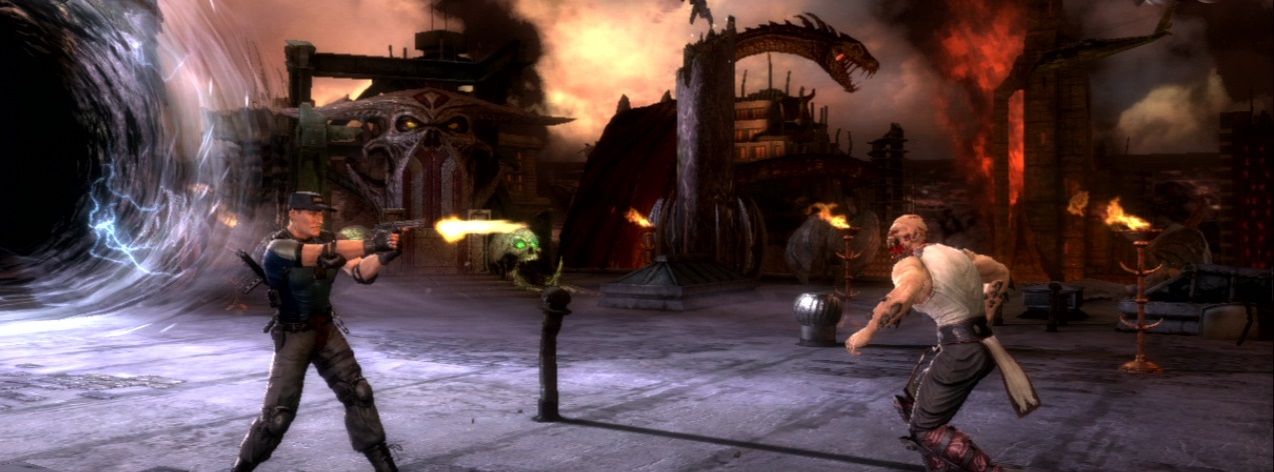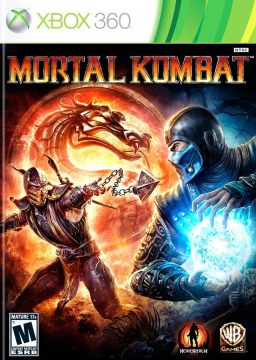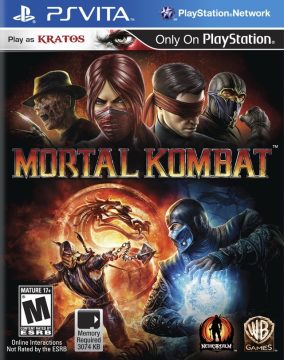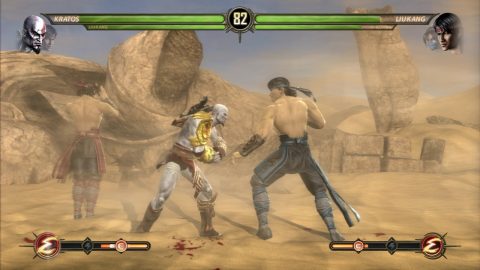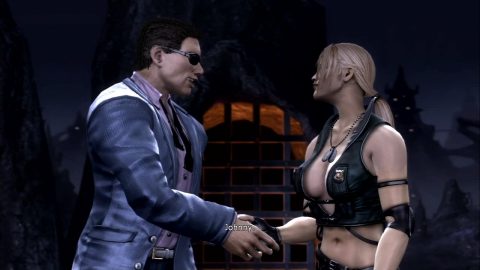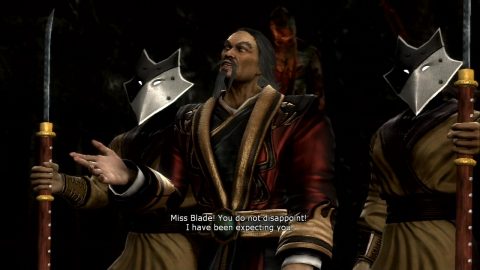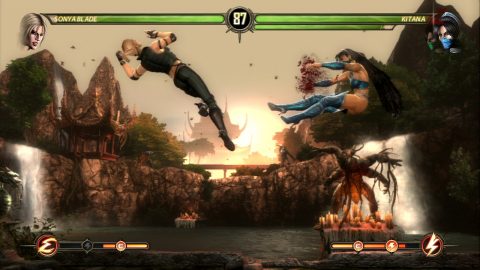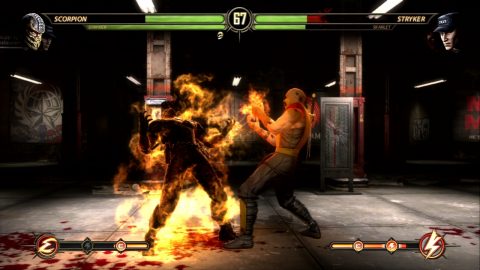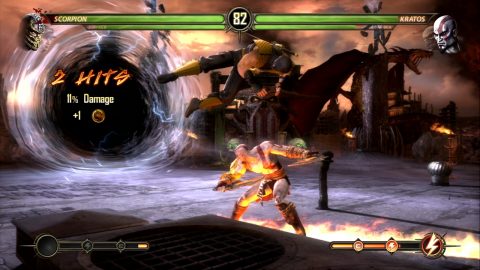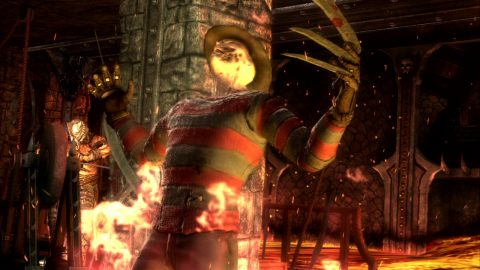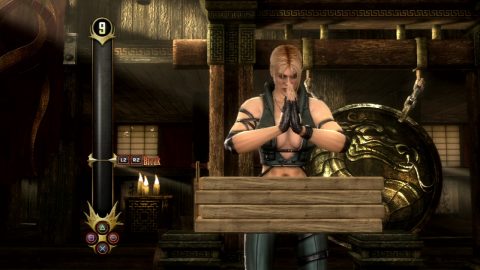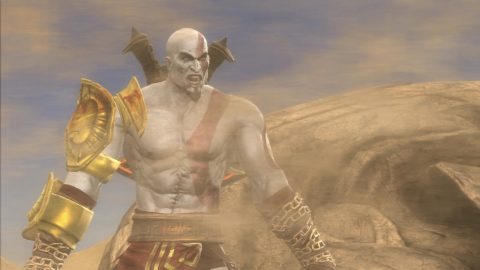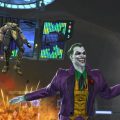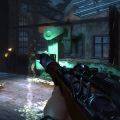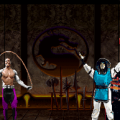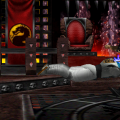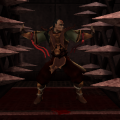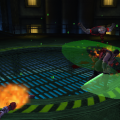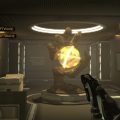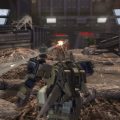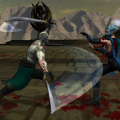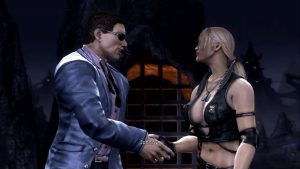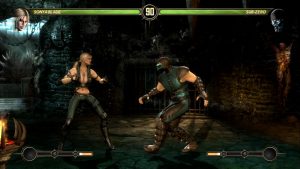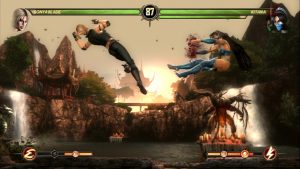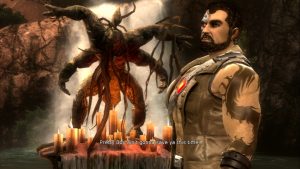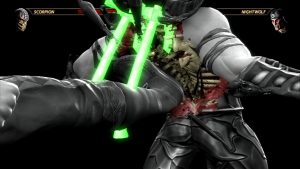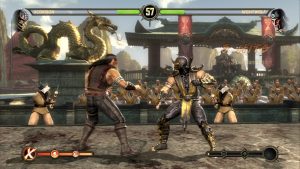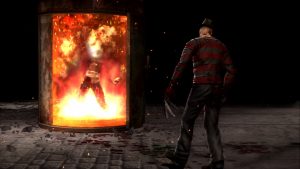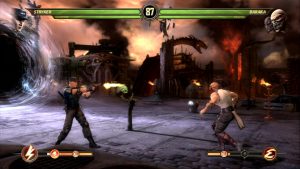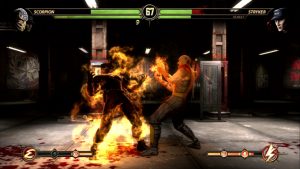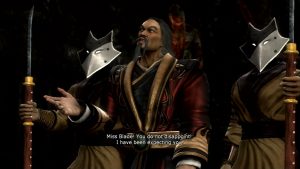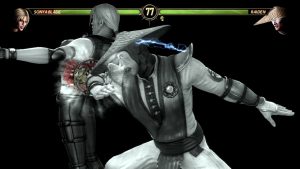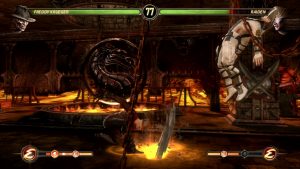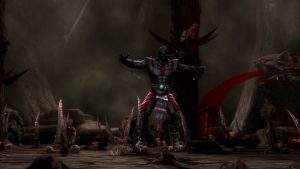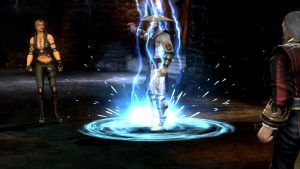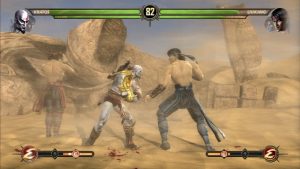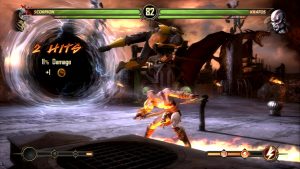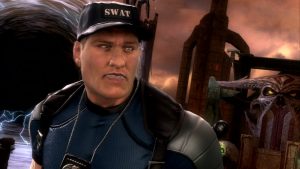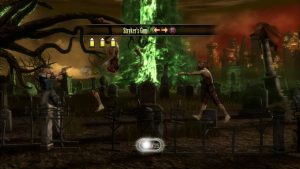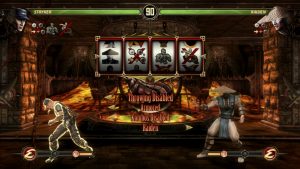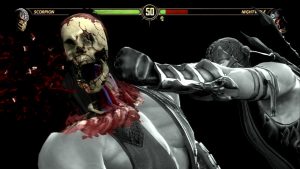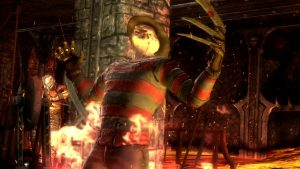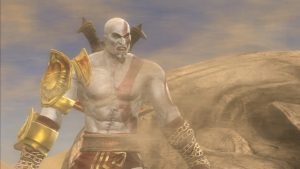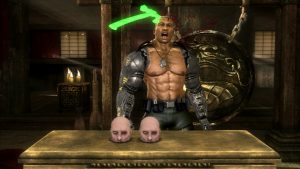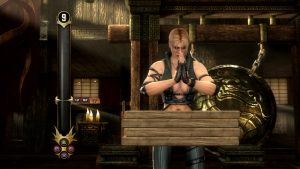- Mortal Kombat (Introduction)
- Mortal Kombat (1992)
- Mortal Kombat II
- Mortal Kombat 3
- Ultimate Mortal Kombat 3
- Mortal Kombat Trilogy
- Mortal Kombat 4
- Mortal Kombat Mythologies: Sub-Zero
- Mortal Kombat: Special Forces
- Mortal Kombat: Deadly Alliance
- Mortal Kombat Deception
- Mortal Kombat: Shaolin Monks
- Mortal Kombat Armageddon
- Mortal Kombat VS DC Universe
- Mortal Kombat (2011)
- Mortal Kombat X
- Mortal Kombat (Miscellaneous)
Things were looking bad for the series after MK vs DCU. Most fighting game players ignored the game on release, seeing it as one last desperate cash grab before Midway’s inevitable bankruptcy. The hardcore fans shunned the game for its whole premise, along with its toned-down level of violence. While MK vs DCU was, to be fair, a major step up from the 3D Mortal Kombat games of the past, it just wasn’t enough. With the news of Midway’s death, most people had assumed Mortal Kombat would become another relic of the 1990s. A year later, the release of Street Fighter 4 revitalized the fighting game genre, which had fallen to the wayside since the days of the PS2.
Some time later, the announcement came that Warner Brothers had taken over the Mortal Kombat team, now known as NetherRealm Studios, and a Mortal Kombat reboot was in the works. After the failure of MK vs DCU, people were understandably skeptical. Eventually, the game was released, and it turned out to be everything the fans were wanting, and more. To put it simply, this is the best Mortal Kombat there is. Not only does it easily beat out all of the 3D games before it, but it even manages to outclass the 2D ones by a mile. If you’ve had any interest in the series at all, this is the game you want to go for.
The game is mostly a retelling of the first three games in the series, with bits and pieces from the newer games added in. Some of the characters have had their backstories changed around, like Kabal now being a New York cop. The roster is made up of everyone from the first three games, with Quan Chi being the game’s only MK4representative. If you pay for the DLC, you can add Rain and Kenshi to the roster. Although the cast is mostly familiar, there’s a few new faces, too. Also, for the first time in the history of the series, Mortal Kombat has now joined the ‘guest fighter’ bandwagon, introducing Freddy Krueger and – only on Sony hardware, of course – Kratos from God of War.
The basic plot for the standard arcade mode isn’t all that different from MK2, where Shao Kahn is being an evil jerk and you have to work your way up the ladder for a chance at him. The real meat of the game’s plot comes from the Story Mode, which makes a return from MK vs DCU. The story is split into sixteen chapters, each focusing on a different character. You watch a cutscene, a fight begins, you change characters every few fights, then the credits roll. That’s not to say it’s not presented well, since the plot’s presented through in-engine cutscenes. The entire mode goes on for about two hours with just the cutscenes alone, and if you were to put it all together, you get something that would make a much better movie than either of the actual MK movies ever were.
The story takes place shortly after the events of Armageddon, where everybody, from Scorpion to Sheeva, is very, very dead. Everybody except Shao Kahn, anyway, who’s busy beating the crap out of Raiden while doing what he does best: gloating. Before he’s struck down, Raiden sends a mental message to himself in the past, in an attempt to fix the future. Unfortunately, the only thing he has time to get out is the cryptic “He must win.” The message manages to reach Raiden shortly before the first tournament begins, and most of the story involves past Raiden trying to figure out what his future self meant. The story starts off by following the story of the original games, with a few changes here and there. A lot of the characters from the later games have been retconned to have them around since the original tournament.
It’s kind of neat getting to see how events that were only mentioned in the past actually played out, like the original Sub-Zero’s death at the hands of Scorpion. Around the last few chapters, however, things start to diverge rather heavily from the original timeline. Since this is Mortal Kombat, it’s not really a spoiler to say that things get pretty dark near the end. While it’s not a complete loss for Eathrealm, that doesn’t make things a lot better. It’s a pretty bleak story overall, although there’s enough funny moments, like pretty much every line Johnny Cage gets, that it isn’t overwhelmingly so. If you’re a really hardcore fan of the series, you might object to some of the changes made to the plot and characters, but even then, this is still the best possible way to experience MK‘s story. Some of the twists near the end, however, feel kind of “cheap,” especially with how much of an impact they have on the characters.
A major flaw of the series, even all the way up to vs DCU, is that the characters felt a little indistinct, to put it kindly. Sure, you could get a glimpse of what they were like by reading through their biographies and looking at their Fatalities. But besides that, it wasn’t exactly easy to tell what made ‘yellow ninja’ all that different from ‘blue ninja.’ This new game does a lot to fix that issue, which gives the characters a lot more personality. For the first time, the characters actually have introduction poses before a fight starts, much like what you’d see in Street Fighter 4 or any other 3D fighter. Even if you’ve never played a Mortal Kombat game, seeing Scorpion jump out of a flaming pit and screaming “Vengeance will be mine!” will probably give you a decent idea of his personality. There’s a lot more unique animations for each character. So many, in fact, that everybody has their own animation for moving away from the opponent if they’re too close to them at the end of the round. Each character also has a win pose if they don’t perform a Fatality, some of which are worth seeing more than the Fatalities themselves. Stryker, for example, calmly turns his back on his opponent, throws a grenade behind him, and doesn’t even flinch as the blood from his opponent splatters onto him.
Nobody’s going to play any fighting game for plot alone, of course. This marks MK‘s fourth reconstruction of the fighting mechanics since 1992, and this time they’ve finally managed to get it down to something that works great. While the characters and background are rendered in 3D, the fighting itself takes place on a 2D plane, serving as sort of a mixture of the classic games and the newer games. Even better, all the weird gimmicks that have plagued the 3D games are gone entirely, which means no more dealing with multiple styles, stage transitions, or whatever Klose Kombat was supposed to be. The speed of the game has been cranked up several notches since DCU. It’s not quite the speed of say, Marvel VS Capcom 3 or BlazBlue, but all the fights have a very fast, aggressive feel to them, sharing the same sort of quick pace Mortal Kombat 3 offered.
The controls have also been redone, taking a more Tekken-esque setup, with two buttons for a fighter’s front and back arms, and two for their front and back legs. You’ve also still got the block button, which may be an annoyance to people more used to the traditional ‘hold back to block’ method. Throws are done either by hitting Front Punch and Front Kick together, or hitting the R1/RB button, and can be done in either direction. Every throw has its own unique animation, too, like Freddy turning the opponent around, shushing them, and then jamming his glove through their chest. You also have a button that changes which way your fighter is facing, but outside some of the really advanced combos, this is more or less useless. Every fighter also has a short dash they can perform by double tapping forward or back, which is for good for closing in distance quickly or extending combos.
Every fighter has an assortment of command moves along with a list of chain combos. Thankfully, these combos only usually come up to about two or three hits, meaning that you have to worry less about memorizing and more about when to actually use them. What’s really nice is that every character has a lot more unique attacks than they did in any of the previous games, which really helps them feel much more distinct. Sub-Zero slashes his opponents with an ice sword, Cyrax beats people over the head with one of his bombs, and Baraka no longer has to give up a kick button to be able to use his blades. After a 20 year history of characters who didn’t feel very distinct when it came to basic moves, this is a huge improvement that adds a lot of personality to each character. Of course, all the characters still have the classic sweeps and uppercuts, but they’ve become so much of an MK staple at this point that something would feel missing if they weren’t there. The ground attacks from DC Universe are gone, but you do have a few more options when you hit the ground. It’s possible to pull off a special move as soon as you get up, delay getting up to throw off your opponent’s attacks, or roll in either direction.
The combo system still has the improvements it’s been given in the previous game, meaning that actually performing them doesn’t feel as rigid and pre-programmed as they did in the earlier 3D episodes. The chain combos do decent enough damage, but with the tightening of the juggle system, they’re better used as a starting point to mix your special moves in, leading to bigger combos and more damage. Much like the 2D games, most of the more effective combos involve trying to find new ways to keep your opponents airborne through skillful use of your combos and special moves. The timing on stringing attacks together is pretty lenient, and the whole system feels a lot more natural in practice than the one frame link system of Street Fighter 4. There’s still a bit of memorization involved in remembering which combos do what, but for the most part, you’re generally given a lot more freedom. The game also reuses the simplified move inputs that started with Deadly Alliance, which makes combos much easier than they were in any of the 2D games.
The biggest change to the system is that you actually have a three-tier super meter. That’s right, none of this ‘Aggressor’ or ‘Rage’ silliness, we’re talking an actual, Capcom-style meter. The meter is separated into three bars, and you fill it up by performing special moves, taking damage, or hitting a blocking opponent. A single bar lets you perform an enhanced special move by hitting the block button at the same time. These work a lot like the EX moves in Street Fighter 3 and Darkstalkers, and they generally give special moves extra damage, reach, speed, or other properties, like super armor. Using the enhanced version of Sub-Zero’s ice ball, for example, will turn it into an ice beam that reaches all the way across the screen. Two bars will let you do a combo breaker by hitting forward and block, good against somebody who has you trapped in a nasty juggle.
A full meter lets you perform an X-Ray Attack, which is basically Mortal Kombat‘s answer to Street Fighter 4’s Ultra Combos. Hitting both triggers when your super meter is full makes your character perform some kind of move, like a grab, a dashing strike, a projectile, or a parry. If you manage to hit the opponent with this move, you’ll land a devasting series of hits on them, taking away a big chunk of their health. This is Mortal Kombat, so these are all pretty brutal to watch. With each hit, you get an internal shot of your opponent’s insides getting smashed into dust. Limbs snap, eyes get gouged, skulls fracture, vertebrae shatter… if this were any other piece of media, nearly every single one of these moves would kill the opponent with the first hit alone. It’s a wonderfully brutal way of putting some extra violence in standard gameplay. The X-Rays also generally don’t take as long as the Ultras in Street Fighter 4, either, so while there’s a little bit of delay while they play out, they don’t hurt the flow that much. It’s also possible to work X-Ray Attacks into combos, although the combo scaling means they don’t do quite as much damage as they do on their own.
The meter adds a lot more strategy than any MK game before ever offered. A lot of it now involves how you want to use your meter, and when. The X-Ray attacks are powerful, but if opponents see them coming, they can block or dodge them, leaving you without any meter to protect yourself. You might want to use one of your enhanced moves instead, or save some meter in case you get caught in a combo. The game generally feels a lot smoother than any Mortal Kombat before, and the super meter adds a lot of much needed depth to the series. It’s not quite as technical as say, Guilty Gear or Third Strike, but it’s also a lot easier to get good at. It’s also a pretty well balanced game, too, with no characters that are so underpowered they’re useless. While it’s true that a handful of characters tend to be much easier to be effective with than others, but that’s an issue that’s hardly exclusive to MK alone. The new elements give the game more of a more polished feel, one that definitely helps the game stand with other fighting games, but there’s still enough of its own features in there that it’s still unmistakeably a Mortal Kombat game.
A new also 2v2 Tag mode for the Arcade and Versus modes has been added, previously explored by the Noob Saibot and Smoke duo in Deception. Here, it’s been reworked to be more like Capcom’s vs games. Much like the vsseries, you have to take out both of your opponent’s characters to win a round. Swapping out characters won’t leave you quite as open as it does in those games, but the tradeoff is that your partner’s health doesn’t regenerate. You can also perform two kinds of tag assists at the cost of one bar of the super meter. One makes your partner jump in and perform an attack before leaving again, while the other has them attack and switch control over to them.
Besides the story mode, you still have the standard arcade mode, which you can play in either single mode or tag mode. This time around, you’ve got three bosses to deal with before you earn your ending, and each of them can be pretty challenging. None of them are nearly as painful as what you’d come up against in the arcade, at least. The first boss is a pumped-up Shang Tsung. He’s got more health than his playable version, plus he can switch between multiple forms, unlike playable Shang. It’s a pretty nice callback to the original game, especially since the costume he wears for the fight is straight out of the original MK. The boss after Shang will either be Goro or Kintaro, and here’s where the game starts getting more challenging. It’s not that they’re as unfair as their MK1/MK2 incarnations, it’s just that they have much more health than you do, along with super armor that seems to activate itself at the worst times.
Get through that, and you come up against Shao Kahn, once again taking the seat of final boss after a six game absence. And don’t get him confused for the playable weakling that showed up in Deception, Armageddon, and MK vs DCU. Shao Kahn is back in full swing, and he’s teaching a whole new generation of fighting game players pain. Not only can he inflict a ton of damage, but he also has much more health than you do, and he has the same new super armor Goro and Kintaro get. If that weren’t enough, he gets an unblockable hammer projectile that makes you dizzy if it connects, leaving you open for a combo or his X-ray, whichever he feels like. And yes, he will taunt you, and he will tell you that you suck, something at least Street Fighter 4‘s Seth was kind enough to refrain from. The good news is that unlike the arcade games, he actually gets easier the more credits you spend fighting him, and the more he’ll taunt and leave himself open. If you manage to beat him, you get to watch your fighter deliver a very satisfying beatdown before, as Mortal Kombat tradition dictates, he explodes violently. The endings are still drawings with limited animation, but it is a lot more than the single image MK vs DCU gave you for winning. The endings are pretty interesting, even if most of them are sadly probably not going to end up happening. As much as we all wish Kano would become Skynet.
For the first time since Mortal Kombat 3, the secret fights return. If you pull off certain conditions during the arcade mode, you’re sent to a secret fight against either Noob Saibot, Jade, Smoke, or Reptile. These take place in the same arena you’d fight them in the original game, and they wear the same outfit as they did in their first appearance. The hidden versions of the characters are also a lot tougher than their normal counterparts: Jade is completely immune to projectiles, Noob Saibot has more health, while Smoke and Reptile get a speed boost, along with Scorpion’s spear. Beating one of the secret challengers earn you a big koin bonus, so they’re worth seeking out.
If you finish the arcade and story modes, you’ve still got the Challenge Tower mode to keep you occupied. The Challenge Tower contains a set of 300 missions, usually with a pre-selected character. The first few missions are basically tutorials for the controls, but the further in you go, the weirder the challenges get. In one mission, you have Scorpion fight off Mileena, who’s desperately trying to give him her teddy bear. Another mission is a mini game where you play as Jax, using his energy waves and ground pounds to keep away approaching Tarkatans. The 150th challenge lets you play as Goro, the only time in the game where he’s actually playable, which makes a great reward for making it that far. Not all the challenges are that interesting, since most of them are a one round fight with certain conditions applied to it, but finishing the tower should give you a good while. Some of the challenges can get pretty nasty, so the game’s nice enough to let you skip them by paying some of your koins. Actually finishing the tower will unlock a new costume for Mileena, which may be worth it to some, and very much not worth it for others.
Also included in the tower are a few other mini games. One of these is Test Your Might, something that hasn’t been seen in the series since Deadly Alliance. This works just like it did in the original arcade game, where you mash the face buttons to build up your power meter, then hit block when you’re ready to hit whatever’s in front of you. Test Your Strike is a variation on this, where you have to build your power only to a certain point before you hit the block button. Test Your Sight also returns from Deadly Alliance, which is this time a much more morbid take on the old shell game. Guess right and you get some koins out of it, guess wrong and you’ll end up with some horrible death befalling you. You can choose to play either of these challenges from the main menu whenever you want, but you won’t get as big of a koin payout as you would from the challenge tower.
The last of the mini games, and probably the most interesting, is Test Your Luck. In this mode, a fight begins, but before it starts, you roll a slot machine. Whatever reels you get will add extra conditions to the fight for either you, your opponent, or both of you to deal with. Some of these are just for visual effect, like Zombie Kombat, which turns both players into rotting corpses. Others give handicaps or bonuses to one of the fighters, like disabling blocking or giving them a speed buff. Other reels are just weird, like one that causes homing missles to fall out of the sky and start locking on to one of the fighters, or one that makes pillars of fire burst from the ground. You can also do Test Your Luck from the main menu with one or two players, and the more challenges you beat in the Challenge Tower, the more reels you can use. Test Your Luck is basically the party mode, since it tends to be incredibly random with its effects. It’s still a lot of fun, though, especially when you’ve got a match about two armless zombies trying to avoid homing missles, while everybody’s got unlimited super.
You can spend all the koins you earn in the Krypt, which is now an open graveyard split into separate areas. Everything you can buy is represented as a grave or a tomb, which bursts open and releases a soul upon purchase. Sadly, there’s not a whole lot worth getting in the Krypt this time around, which is a shame considering how much stuff there was to buy in Deadly Alliance and Deception. There’s concept art you can buy, some of which unlocks alternate costumes, Fatality inputs, music, or Kombat Kodes that work like the ones in MK3, but that’s about it. While there was a lot of goofy stuff in the earlier games, there was a lot of concept art that showed off scrapped ideas and how the game changed in development, and you don’t get any of that here. Like in Deception, every coffin will always have something in it, but this time around, the Krypt has an entirely brand new way to troll you.
Much like any good modern fighter, you’ve also got an online mode. Although, you might want to stick to playing against friends, because, as with any fighter, you’re very likely to run into players who murder you in seconds flat. There’s also a ‘King of the Hill’ mode, where people line up to fight the current champion of the hill, taking their place if they manage to beat the crownholder. A nice touch is that all the players are represented as super deformed versions of the MK characters, and by putting in certain combinations, you can react to the match you’re watching, like throwing tomatoes at the screen or blowing the horns.
Of course, we can’t forget the Fatalities, after the poor showing they made in vs DCU. They’ve been massively improved since then, and they’re even bloodier than in the earlier 3D games. Every character gets two Fatalities, with some being callbacks to earlier games, and some being all new. One of the new ones has Noob Saibot and his shadow clone grab the enemy by the legs and rip them apart like a wishbone, crotch first. They’re not all winners, of course, but they’re all guaranteed to be fatal, unlike a few of the Fatalities in vs DCU. There’s also a new Fatality tutorial mode, where you can practice the exact inputs and ranges you need to pull off your Fatalities. Stage Fatalities also return, and these are pretty brutal in their own way, like grabbing the opponent and shoving them head first in a pool of lava. As the opponent tries to pull themselves out of it, lava pouring out of their eye sockets, the victor just stomps their head right back in. Nasty.
A bigger surprise, though, is that they actually brought Babalities back. If you can manage to pull them off, every character you perform a Babality on will have their own unique animation, which makes it worth trying them on everybody. Shang Tsung sucks the soul out of a teddy bear, Scorpion attempts to throw his spear before falling over, and Johnny Cage sketches the victor a terribly drawn autograph. It’s even possible to perform Babalities on the bosses, if you manage to satisfy certain conditions. And yes, it’s entirely possible do a Babality on Freddy Krueger and Kratos.
The new Mortal Kombat is a good looking game, especially when you compare it to how ugly MK vs DCU tended to be. The colors are much brighter (note that the screenshots on this page turn out a bit paled due to the capture method), and the fighters have much more detail to them. The animation is also a little smoother, although there are still points when it seems a little jerky. It’s a minor quibble, but some people may take issue with it compared to the way Capcom handles animation. Where the models really shine is in the battle damage they take, though. The previous games applied bruises, cuts, and minor costume damage to the fighters, but here, even the victor ends up looking like they’ve been worked over with a cheese grater. They get splattered with blood, get their faces caved in, have chunks of their flesh missing, and in the case of the cyborgs, actually have their brain exposed. Most of the stages have been remade from the original three games, and they all look great. The rooftop stage from MK3 is a highlight, since a battle rages in the background between a dragon and a helicopter while you fight. The redone music to go with the stages sounds great, too, and you’re even given the option to use the music from the original games. The fighters also vocalize much more than the previous games, with Johnny Cage screaming out his own name after doing certain specials, and Mileena’s sultry “Don’t be mad!” after pulling off her X-Ray Attack.
While the 360 and PS3 versions of the game are mostly identical, except for the PS3 version having Kratos, the Vita version actually contains all the DLC from the start. This includes all four DLC characters, along with all the outfits. There’s also a hundred new challenge tower missions, with a few missions making use of the touchscreen controls, like a fight where you have to keep wiping blood off of the screen. There’s also a couple of new mini games, like Test Your Slice, which is a much more violent variation of the smartphone game Fruit Ninja. Body parts fly out onto the screen, and you drag your finger across them to slice them while avoiding bombs. In Test Your Balance, you tilt the Vita to keep your fighter from falling off a ledge, while thrown body parts knock you off balance. Falling leads to your fighter plummeting into some kind of deathtrap, like a pool full of piranhas. The later released Komplete Edition for the home consoles also includes all the DLC.
The PC version is a decent port that plays well, although your enjoyment from it will probably come from just how good your PC is. If you want a full 60 frames, you’ll need a pretty recent PC. The online, while it runs off of Steamworks, also has a reputation for being somewhat unstable, and there’s often a good deal of lag. There are also a few things that will instantly crash the game in multiplayer for no reason, such as by opening the friends list with your controller instead of using the Steam overlay. The cutscenes are also of a lower quality than the console versions, although there are fan patches to fix this issue. If you can look past all of that, however, it’s a pretty good port, with a lot of PC-specific graphics options to tweak.
Compared to the almost non-existent response to every previous MK release in Japan, MK2011 ended up being a pretty hot import. So much so, in fact, that some fans apparently made an arcade bootleg version running on a hacked PS3. Unfortunately, there’s little to no information on this version, although it seems to run on modified PS3 hardware.
It might sound like an exaggeration, but this Mortal Kombat does everything so much better than any game in the series before it that it makes almost all of them obsolete in comparison. The gameplay’s been polished and balanced so well that in some ways it manages to trounce Capcom’s own recent efforts. There’s so much more replay value, a much more engaging story, and it’s much easier to learn and get good with than Capcom’s arcane ‘one-frame links.’ Even though this MK serves as more of a reboot of the franchise, it honestly feels like much more of a love letter to everything that made the original series great, but equally improving what made it so dated. This game is pretty much the best way to experience Mortal Kombat, whether you’re new to the series or have been following it from the start.
